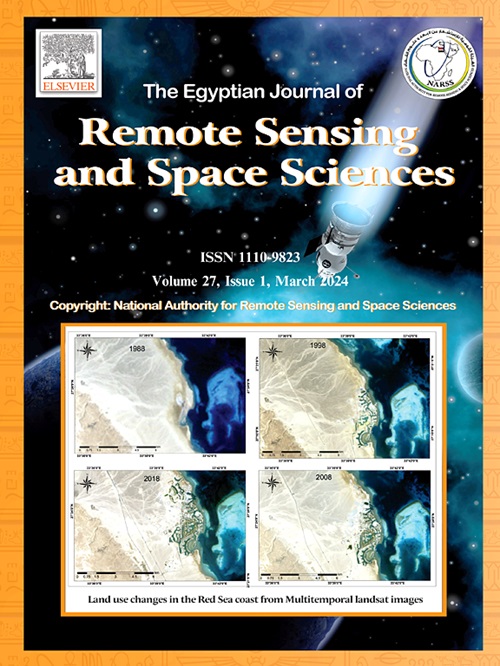Spatiotemporal variations of aquatic vegetation in Maracaibo Lake: Remote sensing and machine learning approach with Google Earth Engine
IF 3.7
3区 地球科学
Q2 ENVIRONMENTAL SCIENCES
Egyptian Journal of Remote Sensing and Space Sciences
Pub Date : 2025-04-22
DOI:10.1016/j.ejrs.2025.04.001
引用次数: 0
Abstract
Aquatic plant invasions endanger lake biodiversity and ecosystem services, resulting in significant economic losses for local communities. Therefore, it is crucial to accurately delineate the extent and frequency of development, but traditional methods are costly and in remote areas. Cost-effective methods, such as satellite monitoring are required. This study uses a Random Forest classification model in the Google Earth Engine (GEE) with Landsat 7 and 8 images to monitoring aquatic vegetation invasion in freshwater ecosystems. The methodology automates the selection of training samples through a dynamic adjustment that incorporates the Otsu-Canny Edge algorithms applied to a vegetation index, allowing for monthly updates while minimizing human bias. Applying this methodology to Lake Maracaibo, Venezuela, between 2013 and 2021, there was a significant increase in floating aquatic vegetation cover, from ≤10 % in 2013 to 25.63 % in 2021, particularly along the northwest coast and the Strait of Maracaibo. This increase could be attributed to a combination of natural processes like precipitation patterns and increased anthropogenic inputs from human activities. The model achieved high accuracy (>0.80), as evidenced by the confusion matrix and cross-sensor comparison. This approach provides a tool for continuous long-term monitoring that can be applied to other eutrophic lakes, improving our understanding of the effects of invasive vegetation, and assisting resource managers and policymakers in developing sustainable management strategies.
马拉开波湖水生植被时空变化:基于谷歌Earth Engine的遥感与机器学习方法
水生植物入侵危及湖泊生物多样性和生态系统服务,给当地社区造成重大经济损失。因此,准确地划定开发的范围和频率是至关重要的,但传统的方法成本高,而且在偏远地区。需要具有成本效益的方法,例如卫星监测。本研究利用谷歌Earth Engine (GEE)中的随机森林分类模型和Landsat 7和8图像对淡水生态系统中水生植被的入侵进行了监测。该方法通过将Otsu-Canny Edge算法应用于植被指数的动态调整来自动选择训练样本,允许每月更新,同时最大限度地减少人为偏差。将该方法应用于委内瑞拉马拉开波湖,在2013年至2021年期间,浮动水生植被覆盖率显著增加,从2013年的≤10%增加到2021年的25.63%,特别是沿西北海岸和马拉开波湖海峡。这种增加可归因于降水模式等自然过程和人类活动增加的人为输入的结合。从混淆矩阵和跨传感器比较可以看出,该模型达到了较高的精度(>0.80)。这种方法提供了一种可以应用于其他富营养化湖泊的持续长期监测工具,提高了我们对入侵植被影响的理解,并协助资源管理者和政策制定者制定可持续管理战略。
本文章由计算机程序翻译,如有差异,请以英文原文为准。
求助全文
约1分钟内获得全文
求助全文
来源期刊
CiteScore
8.10
自引率
0.00%
发文量
85
审稿时长
48 weeks
期刊介绍:
The Egyptian Journal of Remote Sensing and Space Sciences (EJRS) encompasses a comprehensive range of topics within Remote Sensing, Geographic Information Systems (GIS), planetary geology, and space technology development, including theories, applications, and modeling. EJRS aims to disseminate high-quality, peer-reviewed research focusing on the advancement of remote sensing and GIS technologies and their practical applications for effective planning, sustainable development, and environmental resource conservation. The journal particularly welcomes innovative papers with broad scientific appeal.

 求助内容:
求助内容: 应助结果提醒方式:
应助结果提醒方式:


